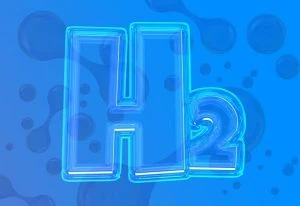Hydrogen Vehicles
Hydrogen-Fuelled Hiace Van Tested for Light Commercial Duties

Fancy a new van for the business? Like, I mean a really cool new van that runs on hydrogen… Well, this fancy might just be getting fulfilled a little sooner thanks to some Australian business owners who have been given a Toyota Hiace with a hydrogen-powered internal combustion engine (ICE). Yes, that’s right – hydrogen ICE – like the old school ICEs but with new technology that can allow for the cleaner burning hydrogen fuel to be burned as a much cleaner option.
Toyota’s Hydrogen Hiace Van has been undergoing testing by local businesses to see how the hydrogen ICE performs and fulfils its role for powering the Toyota Hiace van while it carries out its daily duties in the real world. If the testing goes well, showing that Toyota’s new Hydrogen ICE is a goodie, then the legendary car manufacturer will set about putting these sorts of vehicles into production.
Let’s start with what’s under the bonnet?
Toyota has designed and built the van’s hydrogen ICE, which is based on the V6 turbo-petrol ICE used in the Land Cruiser 300 model series. The LX600’s 10-speed automatic transmission has been retained in the test van, but it runs with rear-wheel-drive rather than the Land Cruiser’s all-wheel drive system. In petrol form, the V6 is able to pump out 305 kW of power and 650 Nm of torque. In hydrogen form, with the relatively minor changes, the motor puts out a decent 120 kW and 354 Nm. Toyota engineers deliberately matched the 120-kW output found in the standard Hiace 2.8-litre turbodiesel that is currently for sale. The diesel unit provides 66 Nm more torque; however, the new hydrogen ICE prototype’s output and torque sounds pretty decent for a Hiace van, which will be used primarily in business logistics and, obviously, as a trade van, which is classed in the light commercial segment.
The hydrogen fuel is stored under the van’s floor in three tanks, which is good for a range of up to 200 km. What about the emissions from the exhaust? Tailpipe emissions amount to a little bit of nitrogen oxide, and that’s it.
So why hydrogen instead of an EV Hiace?
There is the lack of emissions, but also the fact that a hydrogen Hiace van can theoretically be put into production quickly without any major changes to Toyota’s supply chain, which make the hydrogen alternative desirable from a cost and logistical point of view.

There is also the fact that Toyota gurus, and other tests, have shown that electric vehicles lose a significant amount of range when they are fully loaded up, working hard, or used for towing. Add in the fact that the van shape isn’t the most aerodynamic outline on the market, then we can see why an EV van starts to look a bit sketchy in the real world. Hydrogen, as a fuel, is far more suited for a van that will work hard with heavy loads on board, run against headwinds, or be used for towing. With hydrogen, the driving range is not as significantly impacted as what it is in an EV alternative, so the panic of running out of battery range in between jobs won’t be a concerning issue for your typical tradie – or the person waiting for the plumber to turn up to fix the loo.
Toyota is likely to bring out an Electric Hiace anyway, but they would also like to be able to provide a hydrogen Hiace in the future as well; obviously not straight away, but for when the infrastructure for hydrogen refuelling does become a reality.
On all accounts, it seems that it the prototype Toyota Hiace Hydrogen Van is capable of doing its job well, and really could be all ready for action at the drop of a hat or once the hydrogen infrastructure arrives.
Hydrogen-Based ICE?

How does a 2.0-litre 4-cylinder engine boasting 302 kW of power at 6500 rpm and 500 Nm of torque between 3000 and 4000 rpm sound to you? To my ears, this is pretty impressive stuff on any given day.
Big entities AVL Racetech and Hungarian HUMDA Lab have used their know-how to work on advancing the hydrogen internal combustion engine (H2 ICE). These engines have long been known for their low performance and lean-burning capacity, but AVL Racetech and Hungarian HUMDA Lab have succeeded in producing something that changes this impression completely.
According to Toyota, the future of vehicle transport and mobility lies in this new type of engine and its resulting powertrains. The 2.0-litre H2 ICE was put through its paces on a testbed and confirmed that the following top values calculated previously in simulations were a reality. Apart from the benefits that the H2 ICE has for the planet in reducing fuel emissions, the level of power that this new technology can produce is staggering.
To put some context on the level of power that this 2.0-litre H2 ICE motor produces, let’s think of it this way. The brand new engine can reach highs of around 153 kW (205 horsepower) per litre, which is even more than the Bugatti Chiron’s 185 horses per litre!
Cleverly designed PFI water injection systems moderate the combustion in the chambers and prevent any potential engine damage from occurring. The PFI water injection system introduces water into the intake air, which improves pressure levels. It also reduces the temperature of the combustion chamber as it evaporates. The air demand, which is lower than during lean combustion, is provided by a waste gate turbocharger that has been especially designed for the sole purpose of improving pressure levels and reducing the combustion chamber’s temperatures.
The H2 ICE process differs from hydrogen combustion in a fuel-cell vehicle, which works more along the lines of a traditional engine but using hydrogen instead of gasoline. So, the H2 ICE converts hydrogen into electrical energy to power an electric motor.
The H2 ICE project leader, Paul Kapus, Manager of Development Spark Ignited Engines, stated that. “At the end of 2022, we announced for the first time, that we would be working on a two-litre, hydrogen-powered racing engine with stoichiometric combustion and PFI water injection… Our goals were 500 Nm of torque and an output of up to 300 kW… We are proud to have been able to validate those figures on the testbed.”
Ellen Lohr, the director of Motorsport AVL, mentioned that the results of the testing of the new motor means that it is a competitive racing package with this technology. The goal for the AVL Racetech team is to lead motorsport into a sustainable future. The next step will be to test the new H2 ICE concept in the heat of battle on a racetrack.
This technology could surely influence the direction of EVs into the future. Watch this space!
Hydrogen Fuel Cell Vehicle: What You Need to Know

As the automotive industry continues to evolve, so does the landscape of fuel alternatives.
Although the market was traditionally dominated (if not monopolised) by petroleum and diesel engines, the recent rise in alternatively fuelled vehicles is reshaping the way we think about transportation.
Today, there are many potential ways of fuelling a vehicle, such as:
- electric vehicles (EVs)
- hybrids vehicles
- biodiesel vehicles
- propane vehicles
- compressed natural gas (CNG) vehicles
One fascinating addition to this list is the Hydrogen Fuel Cell Vehicle, or Fuel Cell Electric Vehicle (FCEV), a fast-growing option in the eco-friendly automotive market.
In this article, we’ll delve into the world of Hydrogen Fuel Cell Vehicles, exploring what makes them unique, how they work, and why they’re quickly increasing in popularity both in Australia and abroad.
So, if you’re considering making the switch to a hydrogen-powered vehicle, this is your guide to everything you need to know.
How do Hydrogen Fuel Cell Vehicles Work?
Hydrogen is the most abundant element in the universe.
When it comes to Fuel Cell Vehicles, hydrogen serves as a clean source of energy to power electric vehicle motors. Unlike traditional petroleum-powered cars that rely on internal combustion engines and emit damaging greenhouse gasses as a result, Hydrogen Fuel Cell Vehicles use a chemical process that involves combining hydrogen with oxygen to create an electric current that powers the vehicle’s electric motor.

Why Use Hydrogen Power fuel in cars?
The appeal of hydrogen as a fuel source for vehicles lies in the fact that it is a green and renewable alternative to traditional fuel sources.
When hydrogen reacts with oxygen in a fuel cell to create electricity, the only by-products of this process are water vapour and heat, making it a zero-emission energy carrier, similar to Electric Vehicles (EVs).
This stands in stark contrast to traditional fossil fuel vehicles, which release greenhouse gases and contribute to air pollution in the short term as well as significant environmental damage over the long term. As the minds of Australians shift toward a more sustainable mindset, hydrogen is an attractive alternative for reducing the carbon footprint of the transportation sector.
How Do Hydrogen Fuel Cell Vehicles Compare against Battery-Electric Vehicles?
Hydrogen Fuel Cell Vehicles (FCEVs) are very similar to Battery-Electric Vehicles (EVs), though, there are some notable differences to be aware of.
While both Hydrogen Fuel Cell Vehicles and Battery-Electric Vehicles aim to reduce reliance on traditional fossil fuels by using electricity as a fuel source, they differ on four key variables:
- their energy storage,
- their delivery mechanisms,
- their refuelling times, and
- their energy density.
On one hand, Battery-Electric Vehicles store electricity in onboard batteries, which are then used to power electric motors. On the other hand, Hydrogen Fuel Cell Vehicles generate electricity on demand through the chemical reaction between hydrogen and oxygen in the fuel cell.
The other key distinction lies in the refuelling times of each alternative.
In short, Hydrogen fuel cell vehicles generally offer a faster refuelling experience when compared to Battery-Electric Vehicles as their battery typically requires a longer charging time.
Additionally, hydrogen has a higher energy density than battery alternatives which allows for more extended driving ranges.
While on the face of it, it may seem as though Hydrogen Fuel Cell Vehicles are a superior choice, it’s also worth remembering that the infrastructure for hydrogen refuelling in Australia is currently less widespread than it is for electric charging stations.
What is the Range of Hydrogen Fuel Cell Vehicles?
Hydrogen fuel cell vehicles are known for their impressive range when compared to other non-petroleum energy alternatives.
The range of Hydrogen-Powered Vehicles can vary depending on the make, model and type of care, as well as how it is driven, however, many models can travel over 600 kilometres in a single trip.
For reference, the average range of a Battery-Electric Vehicle is between 300 and 500 kilometres, making Hydrogen-Powered Vehicles the perfect choice for eco-friendly consumers who enjoy their road trips.
How Do You Refuel Hydrogen Fuel Cell Vehicles?
Although the infrastructure is currently lacking in Australia, refuelling a hydrogen-powered vehicle is a straightforward process. Much like traditional petroleum stations, hydrogen refuelling stations allow drivers to replenish their hydrogen tanks quickly and efficiently.
The refuelling process generally takes just a few minutes and so offers a level of convenience that is comparable to refuelling a traditional petroleum vehicle. While compared to electric charging infrastructure, the number of hydrogen refuelling stations is currently limited, efforts are underway to expand the current infrastructure network to make Hydrogen Fuel Cell Vehicles more accessible to all Australians.
Find the right Hydrogen Fuel Cell Vehicle at the right price with Private Fleet
Private Fleet empowers you to gain all the benefits of a fleet purchase but as a private buyer – and get advice on the latest Hydrogen-Powered Vehicle incentives!
Backed by decades of vehicle industry experience, fleet buying power and a network of car dealers across Australia, we are here to ensure that buying your next Hydrogen Fuel Cell Vehicle (FCEV) will be as straightforward as possible for you.
Shopping for a car is an enjoyable process – let us make it hassle-free, too.
Reach out to us today for a seamless and simple car-buying experience.
Could a Citroën ë-Jumpy Hydrogen be Feasible in Australia?
Currently (July 2022) in Australia, hydrogen refuelling stations are found in Melbourne, Sydney, and Brisbane. Green hydrogen (H2) is a cleaner fuel for running a motor to power a vehicle. H2 is produced using electricity that has been made from renewable resources (sun, wind, hydro) and is one effective way to aid the reduction of unwanted gas emissions. Hydrogen is also the simplest and most abundant chemical element in nature that is almost always bound to another element. It can be used as a clean and inexhaustible energy. You can even create a hybrid vehicle where hydrogen and batteries can combine to propel a hydrogen-ev forwards.

Citroen have created a great light commercial van called the Citroën ë-Jumpy Hydrogen. While it is currently only sold in a few markets in Europe (where there are many more hydrogen refuelling stations), the light commercial van combines the best technologies of a hydrogen fuel cell and a battery for motoring. Perhaps we might be able to get an ë-Jumpy Hydrogen van in Australia to run the Melbourne to Brisbane Hydrogen Highway?
Citroën’s entire light commercial vehicle (LCV) range is already fully electrified overseas, and Citroen say that the ë-Jumpy Hydrogen offers the widest electrified range to meet the heavy demands of business professionals. Citroen Australia is yet to bring any of these ev vans to Australia.
The Citroen ë-Jumpy Hydrogen van has a hydrogen fuel cell and rechargeable batteries, the first Citroën powered by this form of energy. While accommodating this new hydrogen/electric technology, it still manages to retain the practical volume and load carrying capacity. The hydrogen and electric components are integrated into the van’s ingenious design, ensuring that the componentry sizes have no impact on load capacity.

Citroën ë-Jumpy Hydrogen LCV has a range of over 400 km. The three 700 bar carbon-fibre hydrogen tanks are stored on the horizontal below the load floor, which sit next to the battery under the front seats. These hydrogen tanks can be filled in just three minutes!
So how does it all work? The Citroën ë-Jumpy Hydrogen LCV is a fully electric vehicle and benefits from a 45 kW fuel cell that produces electricity by consuming hydrogen. A 10.5 kWh battery takes over automatically once the hydrogen tank is empty. The battery itself is automatically charged using electricity that is generated by consuming hydrogen or by using a cable at any typical electric-vehicle charging station.
The Citroen ë-Jumpy Hydrogen has identical specifications to the Peugeot e-Expert Hydrogen and Opel Vivaro-e Hydrogen vans in the UK. Citroen say that the ë-Jumpy Hydrogen LCV is for businesses that need more than the standard EV van’s 300 km of driving range, or for those who have no time to wait around recharging before getting to the next job. The Citroën ë-Jumpy Hydrogen is expected to offer over 400 km (249 miles) of driving range.
Citroen say that Battery Electric Vehicles (BEVs or EVs) are perfect for all applications with range requirements of 100-300 km a day if there is access to overnight charging. But with the improvements in battery technology leaping forward, time is currently on the side of BEVs/EVs.
Citroën ë-Jumpy Hydrogen specs include:
a total range of over 400 km
3-minute refuelling of the hydrogen tanks
three 700-bar hydrogen tanks (70 MPa), with 4.4 kg of hydrogen under the floor when at full capacity
range with 10.5 kWh battery only being used: 50 km
front-wheel drive
100 kW of power and 260 Nm of torque developed from the permanent magnet electric motor
an 11 kW three-phase on-board charger
2 van lengths available (Medium 4.95 m long, and XL 5.30 m), with the same loading volume characteristics as any equivalent diesel or purely electric versions
cargo space of 5.3 m3 to 6.1 m3
payload up to 1100 kg
towing up to 1000 kg